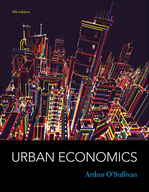Solution Found!
Distance between Bus Stops Consider a city that decreases the distances between bus stops, which decreases the walking time of bus riders by 20 percent, increases the in-vehicle (line-haul) time by 10 percent, and increases operating cost by 10 percent. On the typical bus line, the initial ridership is 1,000 riders per hour. Suppose the elasticity of transit ridership with respect to line-haul time is –0.39 and the elasticity of transit ridership with respect to access time is –0.71. a. Ignoring the change in operating costs, ridership will [increase, decrease] by _____ percent ( _____ riders), computed as … b. If the transit operator passes on the higher operating cost in the form of an increased fare, the combination of shorter distances between stops and a higher fare will [increase, decrease] ridership by _____ percent ( _____ riders), computed as …
Chapter 11, Problem 1(choose chapter or problem)
Distance between Bus Stops
Consider a city that decreases the distances between bus stops, which decreases the walking time of bus rides by 20 percent, increases the in-vehicle (line-haul) time by 10 percent, and increases operating cost by 10 percent. On the typical bus line, the initial ridership is 1,000 riders per hour. Suppose the elasticity of transit ridership with respect to line-haul time is -0.39 and the elasticity of transit ridership with respect to access time is -0.71.
a. Ignoring the change in operating costs, ridership will [increase, decrease] by ___percent (____ riders), computed as…
b. If the transit operator passes on the higher operating cost in the form of an increased fare, the combination of shorter distances between stops and a higher fare will [increase, decrease] ridership by ____percent (____riders), computed as…
Questions & Answers
QUESTION:
Distance between Bus Stops
Consider a city that decreases the distances between bus stops, which decreases the walking time of bus rides by 20 percent, increases the in-vehicle (line-haul) time by 10 percent, and increases operating cost by 10 percent. On the typical bus line, the initial ridership is 1,000 riders per hour. Suppose the elasticity of transit ridership with respect to line-haul time is -0.39 and the elasticity of transit ridership with respect to access time is -0.71.
a. Ignoring the change in operating costs, ridership will [increase, decrease] by ___percent (____ riders), computed as…
b. If the transit operator passes on the higher operating cost in the form of an increased fare, the combination of shorter distances between stops and a higher fare will [increase, decrease] ridership by ____percent (____riders), computed as…
ANSWER:Step 1 of 3
Given data:
The change in line-haul time \(A = 10\% \) (increase in vehicle time).
The change in access time is \(B = - 20\% \) (decrease in walking time).
The change in operating cost \(10\% \).
The initial ridership is \(1000\) rides per hour.
The elasticity of transit ridership with respect to line-haul time is \(x = - 0.39\).
The elasticity of transit ridership with respect access time is \(y = - 0.71\).
